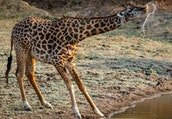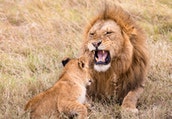- 1. Africa Cheetah Physical Description Cheetahs have a slender and streamlined body built for speed. They have a small, rounded head, a long neck, and a flexible spine that allows for elongated strides while running. They are recognizable by their tan or golden coat covered in black spots. Their faces are marked with characteristic "tear stripes" that run from the inner corners of their eyes down to the sides of their mouth.
- 2. Africa Cheetah Speed and Hunting: Cheetahs are the fastest land animals, capable of reaching speeds of up to 100 kilometers per hour (62 miles per hour) in short bursts covering distances of around 500 meters (1,640 feet). They rely on their speed to chase down and capture prey, mainly small to medium-sized ungulates like gazelles and impalas. Their slender body and lightweight frame, combined with long legs and a flexible spine, aid in their sprinting abilities.
- 3. Africa Cheetah Distribution and Habitat: Cheetahs are found primarily in various sub-Saharan African countries, with small populations in Iran. They inhabit a range of habitats, including grasslands, savannas, scrublands, and semi-deserts. Cheetahs require open spaces for hunting and often avoid dense forests or areas with dense vegetation.
- 4. Africa Cheetah Behavior and Social Structure: Cheetahs are generally solitary animals, except during mating or when a female is raising her cubs. Males often form small, temporary groups called coalitions, usually consisting of siblings. These coalitions provide some advantages, such as improved hunting success and defense against other predators. Female cheetahs are usually solitary, raising their cubs on their own.
- 5. Africa Cheetah Reproduction: Female cheetahs come into estrus or heat for a short period, usually every 12 to 25 days. After a gestation period of around 90 to 95 days, a female gives birth to a litter of typically 3 to 5 cubs. The cubs are born with a thick mantle of fur on their backs, which provides camouflage and protection. The mother cares for and nurtures the cubs until they are independent, usually at around 18 months of age.
- 6. Africa Cheetah Conservation Status: The cheetah is listed as a vulnerable species on the International Union for Conservation of Nature (IUCN) Red List. They face numerous threats, including habitat loss, human-wildlife conflicts, and illegal wildlife trade. Efforts are being made to protect cheetah populations through conservation programs, anti-poaching measures, and habitat preservation.
Africa Cheetah:
The cheetah (Acinonyx jubatus) is a large and distinctive big cat known for its incredible speed and unique physical adaptations. Here are some key facts about cheetahs:
Africa Safari Tour Book online The cheetah safari








 |
|  |
|  |
|  |
| 